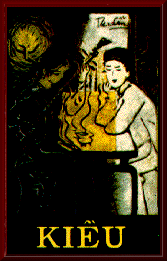Vietnam's Epic National Poem
"Truyen Kieu"
by Nguyen Du
(1766-1820)
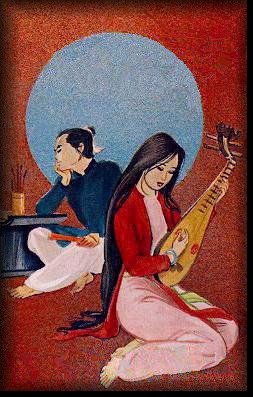
Lecture notes from Mr. Tien
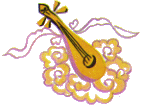 |
Manager, Dong Khanh Hotel, Ho Chi Minh City, to students on Campus Abroad Viet Nam,
July 1998. Mr. Tien was a High School Teacher before he became the manager of the
Dong Khanh. I thank him - JKS. |
 |
I. Biography of Nguyen Du
- Born 1766 into a very learned family
- Father had been a prime minister in the Le Dynasty
- His brothers were high ranking officials in the Le Dynasty
II. Historical Situation
By the end of the 18th century, the Le Dynasty, after almost 300 years on the throne, had been weakened. The king of Le was like a puppet. Power in the country was shared by two big families: The Trinh family to the North and the Nguyen family in the South. The country was at war; the two families fought each other for the power and the king did nothing. The national hero, Nguyen Hue from the Tay Son (Qui Nhon) defeated both the Nguyen family and the Trinh family. Afterward the last king of the Le Dynasty, Le Chieu Thong, went to China to beg for help. He asked the King of China (Thanh Dynasty), King Cau Long, to send troops to Viet Nam to help him gain back the throne of his ancestors. In 1789 Thanh's troops were also defeated by Nguyen Hue, and he became a King by the name of Quang Trung. Nguyen Du and his family had tried to follow Le Chieu Thong (to China), but they had to stay in Viet Nam. They were loyal to the former king of Le and were afraid of the Nguyen Dynasty which took over in 1802. Nguyen Anh overthrew the Tay Sons and he became the new king [the first of the Nguyen Dynasty which continued until Bao Dai abdicated in 1945-ed. note] by the name of Gia Long. Gia Long asked Nguyen Du to join the new government. It was against Nguyen Du's willingness, but he had no choice.
III. The Concept
The Vietnamese are a very learned people and were deeply influenced by the concepts of King-Master-Father of the great Chinese philosopher, Confucius. [He taught that] you must be loyal to your king-no matter what. Nguyen Du and his family had benefited a lot from the former Le Dynasty, which explains why Nguyen Du was unwilling to join the new government. He considered it an act of disloyalty to the former king. As a learned man, he was afraid of being disregarded by the people of his time and felt it would bring shame to his family name, because he was being faithful to the concepts of Confucius.
IV. Kieu's Story
(Also titled the equivalent of The New Scream that Cuts Your Guts)
In order to explain his situation, Nguyen Du was inspired by the story of KIM VAN KIEU by a Chinese author, Thanh Tam Tai Than (pen name). The story had three main characters: Kim Trong, Thuy Van, and Thuy Kieu. The culture of Viet Nam was deeply influenced by Chinese culture. But if we believe that Nguyen Du was only translating the Chinese original we would be mistaken. Nguyen Du only wanted to borrow that story to convey his concept, his situation, his memory of the dynasty that had been lost. Furthermore the story was written in [the Vietnamese] 6-8 verse. It was a very popular verse form and everyone, from farmers to learned men, could understand it.
SIMILARITIES BETWEEN KIEU AND THE AUTHOR NGUYEN DU
| Kieu sold herself to settle the debt of her family | Nguyen Du considered the action of joining the new government as selling himself |
| Kieu had to endure suffering and hardship | Nguyen Du suffered greatly because of his loyalty to his former king |
| Deep in her heart, Kieu stays faithful to Kim Trong | Nguyen Du was truly loyal to the Le Dynasty |
| Finally Kieu was reunited with Kim Trong | Nguyen Du hoped for the return of his king |
This is the story of a young lady named Vuong Thuy Kieu. Kieu was very beautiful and
learned as well.
She was born into a well-educated family, and she was in love with a young man, Kim
Trong. Then disaster fell on her family. Her father and her brother were imprisoned.
In order to solve the family's problem, she had no choice but to sell herself. From
then on, catastrophe after catastrophe fell on her. She had to follow her fate: being
cheated, two times being held in a pleasure house (whorehouse) as a singer, concubine,
servant. We may say this is a sad story of a talented lady who had bad fate. In this story
Nguyen Du wanted to tell us through the fate of Kieu to be widened into the fate of
human beings in the wicked feudal society along with its cruelties and injustice.
He wanted to scream out loud, a scream that breaks our heart. Thus the title of the
story DOAN THANH TAN THANH, or as it is more popularly known, KIEU's STORY.
Nguyen Du's inspiration
Nguyen Du tried to explain to us that disaster that befell Kieu is the conflict between talent and fate [See opening lines of the story]. Kieu had to endure a lot of suffering and hardship because she is beautiful and talented. The more you are talented, the more bad luck may strike you.
To Nguyen Du to settle this conflict, the matter of the heart must come into being.
By the end he wrote that the heart is three times more important than the talent.
The inspiration of Nguyen Du's was the inspiration of considering men's fate. How
could men live in a society full of injustice and cruelties? Kieu was built in the
image of perfection, she was the essence of desirability by men. Kieu was not only
beautiful, she was also talented.
In one word she was the perfect combination of beauty and talent. Such a lady must
have a good life with happiness but because she was living in an unjust, cruel,wicked society,
all that she got was turning against her and she fell victim to a disaster that destroyed
her. Kieu had become a victim of the society. But she never accepted her fate; she
was always fighting against it. There was a rebel in Thuy Kieu. We may say that the
more she fought the more she failed, and as she became aware of her fate, her failure
became more bitter.
Nguyen Du was writing Kieu's story with his blood and his tears.
V. The Kieu Story and the Vietnamese People
- 6/8 verses are popular and easy to understand
- The Kieu story is a masterpiece that every Vietnamese knows
- In conversation we refer to citations from KIEU
- In life every event that happens may refer to a part of Kieu's story
- 1st of the New Year. KIEU may be used as a book to predict the future
VI. Conclusion
To solve everything the matter of the heart comes into being;
righteous people will overcome everything toward a better life.
MANY THANKS TO A WONDERFUL TEACHER. Transcribed with permission of Mr. Tien - JKS
Lecture by John Swensson
PART I -- Lecture -- pp. 3-67 -- Kim Trong & Scholar Ma Section
WHY STUDY KIEU? I think the logical place to start is with this passage from Alexander Woodside's "The Historical Background," (xi-xviii) which serves as a preface to the referenced text:
To the Vietnamese people themselves, THE TALE OF KIEU is much more that just a glorious heirloom from their literary past. It has become a kind of continuing emotional laboratory in which all the great and timeless issues of personal morality and political obligation are tested and resolved (or left unresolved) for each new generation. Western readers who are curious about Vietnam and the Vietnamese may well gain more real wisdom from cultivating a discriminating appreciation of this poem than they will from reading the entire library of scholarly and journalistic writings upon modern Vietnam which has accumulated in the West in the past two decades. (xi)
Strong words those; I cannot add to them except to say that an understanding of modern Vietnam, and the roles of Americans and Vietnamese in the recent conflict, is one of the aims of this critical thinking course. A powerful idea that we might understand the recent past by going to the beginning of the nineteenth century. I am reminded of Maxine Hong Kingston's comments to me that by studying war today "we are preventing wars a thousand years from now." (PREVENTING WARS A THOUSAND YEARS FROM NOW, May 1994 taped interview with MHK, on reserve in the Open Media Lab of the LRC). I suppose a secondary aim is to assist our Vietnamese (and Chinese in view of the sources of Nguyen Du's work) students to retain an important part of their culture, and to help non-Asian students to understand our fellows.
ORGANIZATION OF THE WORK
This is fairly straightforward and is illuminated in the introduction by Thong on page xxix. There is a general introduction from pages 3-9 where we meet the Vuong family and the deceased muse Dam Tien, who, although she is only a spirit will eventually speak to Kieu, and who has a real perfume fragrance. The intro. is critical and bears several readings (My recommendation for those of you who are reading this for the first time is that you do a quick read all the way through and then go back and do an analysis in each section, doing a more careful reading and using the wonderful endnotes). It is the detailed introduction to Van and Kieu and young Vuong, and it introduces a number of themes that resonate throughout the work. Notice also that there is a god in the work whom Kieu addresses on p.7. On page 9, after the break we meet the "youthful scholar," Kim Trong, who is an admirable first love for Kieu.
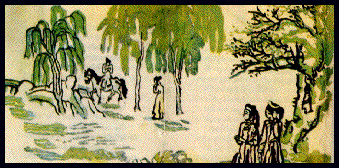
From pages 21-29 their love deepens and it results in a pledge of betrothal. But, alas, on page 29 the plot thickens and Kim must leave for some years because of his uncle's death, and even worse, Old Vuong is arrested on false charges on p.33, and Kieu sells herself into marriage to save the family--the concept of loyalty is an important one throughout. Aided by family friend, administrator Chung, Kieu is sold to Scholar Ma, and Old Vuong is released. Before she marries Ma, Kieu enlists Van to promise to fulfill her marriage vow to Kim (39) .
Scholar Ma and his wife, Dame Tu, are very evil characters (not without some comic relief somewhat reminiscent of the Thenardiers in LES MIS). Note the commingling of the flower, nature, and sexual imagery on pp. 43-45 et. passim.. The melancholy family leave-taking on pp. 47 inspired a playlet put on by my students in Viet Nam in the summer of l998, which was keenly appreciated by the Vietnamese students in their audience at the University of Forestry and Agriculture in Thu Duc, Viet Nam.
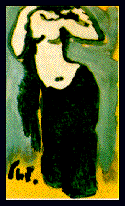
Pages 49-67 are set in the brothel and involve skullduggery, captivity, mirth-- particularly when Dame Tu hears from Kieu that her husband slept with Kieu. Keep in mind that Kieu did not at the time know he was already married. We have a wonderful subplot involving a rogue named So Khanh who promises to help Kieu escape, but is really in league with Dame Tu, and finally we meet a young woman, also held captive in the brothel, who befriends Kieu, Ma Kieu. Dame Tu then offers instruction to Kieu in how to be a good courtesan, and this leads us to a consideration of an alternate translation, and the start of Part II, the Thuc Ky Tham section, which begins on p.67.
(The alternate translation is a prose translation, KIM VAN KIEU, five copies of which are on reserve in the DeCillis Collection, along with several copies of TRUYEN KIEU, in Vietnamese. If you are really into KIEU, and I hope you will be, check out a copy of the prose translation and compare some of the footnotes. While the superiority of the Huynh Sanh Thong translation will readily become apparent, the alternate translation will shed additional meaning for serious students. :-) The prose translation is published in Viet Nam, is titled KIM-VAN-KIEU. and is translated by Le Xuan Thuy. )
KIEU II -- Lecture -- pp. 67-113 Thuc Ky Tham Section
In the introduction, pp. xxx-xxxi , Huynh Sanh Thong starts off by saying that "The love between Kieu and the weak willed Thuc eventually matures into a deep attachment, but sexual attraction is its main ingredient. Thuc meets Kieu as a customer of the brothel. Once again the plot evolves based on the departure of a parent, Thuc's father journeying home by "a stroke of timely luck" (67). While the relationship is a sexual one it soon includes music, poetry, and chess.
Kieu then takes up the notion of her responsibility and Thuc's and urges that there is no future in their relationship given Thuc's attachment to his first wife and she proceeds to forecast all of the doom that will (and does) befall them if they continue. Thuc's argument on p. 71 is that these matter-and Miss Hoan-- are all far away and she should pay them no heed, and as a measure of his serious intent he buys her out of the brothel, and they live together for 6 months until Thuc's father returns. And here the wrath of the father that Kieu had foretold comes home with a vengeance and a trip to the judge.
The father turns them into a judge and it here that Kieu must make a moral choice, choosing to accept punishment for her deeds, or return to the brothel. She replies with grace "I shall endure the thunder of the law" (75). Here she is beaten as Thuc is forced to watch. Thuc's pain is so intense that the Judge's heart is moved, and he shows mercy and orders a wedding. (I am reminded of Shakespeare's Portia in THE MERCHANT OF VENICE dispensing justice and mercy in a European society, that is younger than the Asian societies here. Where is this in American literature?)
Old Thuc's heart is softened also BUT they still have, as Kieu has also foretold, Miss Hoan to deal with-- and her mother!! Miss Hoan is one of the strongest characters in the novel, physically violent and with a malicious cunning that guarantees that Kieu will be punished sorely for her deeds. On Kieu's urging Thuc returns to his wife (79) and we see, especially on p. 83 his weak will that Thong started us off with. His refusal to reveal his relationship with Kieu which was the purpose of his journey shows how weak he is and we as reader experience the dramatic irony of knowing what Miss Hoan knows and what her intent is.
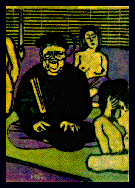
In a brief vignette on pp. 84-85 we meet Miss Hoan's mother and get some insight into why the daughter is so mean--the mother graciously accedes to a scheme that involves kidnap, bondage, and public torture (Hell hath no fury. . .as Shakespeare tells us).
What follows next is the dramatic subplot of the kidnapping and burning of Thuc and Kieu's apartment complete with the planting of an unclaimed corpse which provides more torture for Old Thuc who has to oversee the funeral of what he believes to be Kieu.
Young Thuc returns and consults a psychic--the importance of fortune telling is one that we Westerners do not appreciate--indeed in Viet Nam fortunes are told by the text of THE TALE OF KIEU itself. And the psychic correctly foretells the plot"when you two stand face to face again,/how strange, you will avoid each other's eyes!" (89).
On p. 91 we meet another young girl (cf. Ma Kieu in Part I) who befriends and advises Kieu who is now in the service of Miss Hoan, and the Buddhist notion of karma/justice/responsibility is repeated "Perhaps you must atone for some past sin" (91). But she then continues "but malice [Miss Hoan] brought you here, and not pure chance" (91). This text is so rich you can almost stop anywhere and do a textual analysis-- which is also why the Vietnamese fortune tellers can randomly select any line and tell a fortune from it.
Eventually Miss Hoan softens--although this becomes a necessary plot point for what is to follow--but not before continuing her own plot to humiliate her husband and Kieu by having Kieu wait in them and play music for them together. Miss Hoan finally lets up a bit on p. 99 and grant Kieu's request to become a Nun. Conveniently there is a shrine in the garden that Kieu can be cloistered in, just close enough for Thuc to sneak over to, which he does, all of the time observed by his wife. But the reunion of Thuc and Kieu is quite beautiful and Kieu merely asks his help in her escape. She is willing to forego their own happiness and leave him with Miss Hoan. But alas, Miss Hoan has overheard it all, and Kieu is left no choice but to escape. Like Valjean leaving the Bishop of Digne's house, she takes the silver as she goes.
We next meet the character of Giac Duyen who would make for an interesting paper. I am still not sure what to make of her. A prioress, she instructs Kieu in what nuns are supposed to do and all is well until a pilgrim sees the silver and identifies it as Miss Hoan's . Kieu confesses and Giac asks a neighboring family to provide shelter for Kieu. Alas, "Dame Bac soon proved a colleague of Dame Tu" (109) and Kieu is back in a brothel again. I remain confused by the apparent marriage to Bac Hanh (whose first name means "false") but he is a parallel to Scholar Ma. Indeed the # of times that Kieu is married is a mystery to me. I hear various reports from 2-9 and a textual examination must be aided by more cultural expertise than I possess. Perhaps some of our students have some answers.
The final line worth mentioning in this section "O Great Potter's Wheel, how you treat womanhood (112) certainly sums up one of the major themes of this work, and reminds me of Maxine Hong Kingston's vignette in CHINA MEN called "On Discovery." So much for Thuc Ky Tham and Miss Hoan--though we shall see them again. Time to turn our thoughts to Kieu's next great love, the soldier Tu Hai.
KIEU -- Part III -- Lecture -- pp. 113-67
Tu Hai and Family Reunion Section
A second customer, a General, turns up to buy Kieu from the second brothel, with "A tiger's beard, a swallow's jaw, and brows as thick as silkworms" (113). Note Du's use of nature imagery (and go to the De Cillis Collection and view the lacquerware of Tu Hai on the wall opposite the clock. He is shown in mother of pearl shell with exactly these characteristics and arrows in his back, standing up, deceased--see upright death of Lord Tu, p. 131). Once again it is not clear whether Kieu and Tu Hai are formally married, though note 2212 implies that as does the celebration on pp.117-19. They clearly share a strong love and are happy together. Tu Hai is a very popular general, but not venerated in Vietnamese history because he does not repel foreign invaders as did Tran Hung Dao (the Mongols) or The Trung sisters (the Chinese in 40 A.D.).
We now come to the popular trial scene with the theme of justice, or is it retribution? Ma Kieu and Giac Duyen are invited as honored guests which leads us to believe that Giac was not being duplicitous in Part II when she referred Kieu to the Bac family (107 et. ff.). Kieu first rewards Thuc, though using the ant in the cup metaphor from Miss Hoan, her earlier chief tormentor. Miss Hoan apologizes, reminds Kieu that she had had a change of heart and let her tend the shrine and Kieu forgives her and sets her free!! (I am reminded of the actions of all of the coup plotters and successive governments in South Viet Nam in the early and mid-1960's, which we shall read about in Halberstam's THE MAKING OF A QUAGMIRE, next. Perhaps this is why they constantly forgave each other, reformed, and tried again.)
But the mercy is short lived. Bac Hanh, Dame Bac, So Khanh, Dame Tu, and Scholar Ma are not only executed, but tortured as well. (Perhaps that is why Diem was dispatched in the M113 armored personnel carrier built at the FMC plant on Coleman Avenue in San Jose?)
Giac Duyen takes her leave with a promise of a reunion within five years guaranteed by another seer, Tam Hop. And in that five years Tu Hai is victorious in many battles, accompanied by his first lady, Kieu. The partnership is taken advantage of by Lord Ho Ton Hien whose entreaties convince Kieu to convince Tu Hai that Ho will be an ally, not an enemy. Alas, the end of Tu Hai, because of Kieu's actions (I am reminded of The Moor of Venice & Desdemona, but in that case it was the Moor who was convinced of the wrong thing). We have already noted the powerful death of Tu Hai, and Kieu is once again in captivity, this time playing "Cruel Fate" on her lute for Lord Ho.
And it appears that Kieu marries again (135), forced into it by her captor! And then we start back to the beginning with Kieu communicating with Dam Tien, lamenting her fifteen years of suffering under the cruel "wheels of fate" (137). The next part starts with Giac Duyen and the seer Tam Hop weighing the balance of Kim's actions "When judged for her past sins, Kieu must be charged/ with reckless love, but not with wanton lust" (139). Tam Hop continues:
"She caused one death, but saved ten thousand lives./She knew right thoughts from wrong, fair deeds from foul./ Whose merits equal her good works in truth?"(139).
Let's go back for a minute back to the opening stanza of the poem:
A hundred years in this life span on earth/
talent and destiny are apt to feud./
You must go through a play of ebb and flow/
and watch such things as make you sick at heart/
Is it so strange that losses balance gains? /
There is both the conflict of talent & destiny (individual actions versus fate) and the notion, explained in note 5 that "losses balance gains" refers to a "Chinese adage, which makes the common observation that no one is perfect or enjoys complete happiness, [which] has a Vietnamese equivalent in a folk saying: '[who] gets this loses that'" (169).
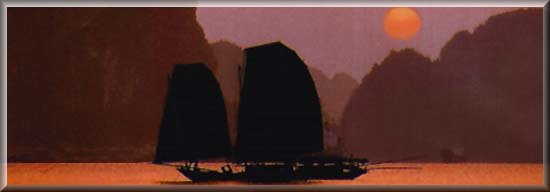
In fulfillment of her dream, Kieu escapes from Lord Ho by jumping into the river- her second suicide attempt? - and after floating downstream is rescued by two fishermen who were there for the purpose of saving her and fulfilling Tam Hop's prediction of Kieu's and Giac Duyen's reunion within five years. And Dam Tien also appears again with a prediction, finally some good news:
with many days ahead, you shall fulfill/
your great past love, reap future happiness./ (141)
But what happened to Kim Trong, Kieu's great past love whom we last saw in Part I?
(Their leave-taking is captured in another piece of lacquerware in the DeCillis Collection, which depicts Kieu and Van, Kim and young Vuong, Kim's horse and the mountains he will journey beyond. The next piece shows Kieu lamenting the absence of Kim. The third piece shows Kieu playing her pear shaped lute form Thuc, and the fourth Tu Hai, noted above)
Kim had come back to the awful news of Kieu's departure and the plot summary in lines 2775 et. ff. is worth noting, but I will not summarize nor quote it here. Kim takes care of the family and sends emissaries looking for Kieu, and to assuage his grief, the family arranges for him to marry Van, which you will recall Kieu had asked Van to do. On page 149 Van dreams that she will be reunited with Kieu, and Old Do, a clerk whom we have not met before, summarizes Kieu's life. This summary leads Kim to find Thuc to get the rest of the story, which continues to the top of p. 153 at which Kim's supposed death by drowning in the river is reported.
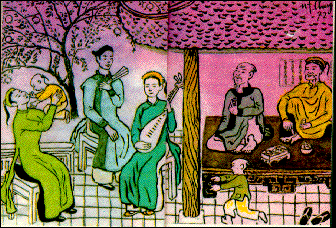
So the family makes an altar to Kieu, it is discovered by Giac Duyen, and we have arrived at the final resolution of the plot for the next 14 pages (remember that half are in one language, half in another-- effectively 7 pages of resolution.) There is little merit in my summarizing this portion. It should be read carefully to be appreciated. Note, though, the solution of Kieu's marrying Kim, but not sleeping with him-- she lives as a nun, because she has lost her chastity. He continues to live and have children with Van. Note also that the family thanks Buddha for the reunion.
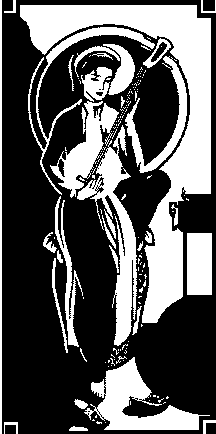
Of Kim and Kieu:
"Of love and friendship they fulfilled both claims--/
they shared no bed but joys of lute and verse/ . . .
Their wishes all came true since fate so willed,/
and of two lovers marriage made two friends./ (165)
[and I hope you the EWRT 2 students have enjoyed these pages of verse.]
Of the story:
"This we have learned: with Heaven rests all things./
Heaven appoints each human to a place./
If doomed to roll in dust, we'll roll in dust;/
we'll sit on high when destined for high seats./. . .
In talent take no overweening pride,/
for talent and disaster form a pair./
Our karma we must carry as our lot--/
let's stop decrying Heaven's whims and quirks./
Inside ourselves there lies the root of good:/
the heart outweighs all talents on this earth./ (167)
and finally the concluding lines
May these crude words, culled one by one and strung,
beguile an hour or two of your long night./ (167)
My wish for you is the same as the author's. I hope you enjoy your study of this great work. Like all great works of literature it returns to you what you invest in it, and you should return to it ten years from now to measure your own change. Its words will still be the same.
Please use the LISTSERV or FORUM -I will post the lectures there also which is a password protected area--to agree/disagree/comment. I have gotten responses so far ranging from "I could not put this book down" to "it is an immoral book that should not be taught in our class." I very much appreciate the comment about morality since this is a critical thinking course, and whether I agree with that opinion is not so important as whether YOU do. Later in the course I want us to consider the morality of American actions and Vietnamese actions in the war. This is kind of like the CLIFF'S NOTES. Now it is up to you to think critically. What are YOUR thoughts? -- JKS
Musashi-bo Benkei and Tu Hai:
Japanese and Vietnamese Heroes, Dying Standing Up
Thoughts from Kayoko Sato
Have you ever heard of Musashi-bo Benkei? Tu Hai, in THE TALE OF KIEU, reminded me
of this famous character in Japanese history.
Benkei became avery faithful follower of the aristocratic warrior Yoshitsune. As a
retainer, Benkei sacrificed his life to protect his master from the attacks ofYoshitsune's
brother, Yoritomo. Even after being strapped with so many arrows and he was mortally
wounded, he stood still, did not let the enemies go by and reach his master. Benkei's
strong will to guard Yoshitsune kept his body "firm as rock and hard as bronze" (Du
131)--just like Tu Hai in the story--and this shows how devoted and committed
he was.
I feel that Benkei and Tu Hai were somewhat similar. I think not only was Benkei loyal to his master, but was proud of himself being a retainer of the great warrior who--Benkei thought he was-- worth sacrificing his own life. And Tu Hai, who was very faithful to his wife Kieu, and who agreed with her to stop expanding his niche and to have a truce, was killed by the government-- his foe. Like Benkei, he stood still even after he was dead.
Both Benkei and Tu Hai died after all, but one thing that I caught a glimpse in their death was that both of them were loyal to the people who they loved, and they died proudly.
My interpretation of Tu Hai may be wrong, but are they not they similar? I think it is very interesting. Regards, Kayo Sato


